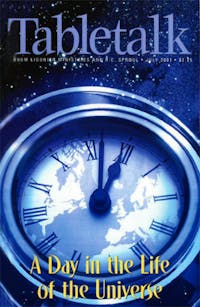
Request your free, three-month trial to Tabletalk magazine. You’ll receive the print issue monthly and gain immediate digital access to decades of archives. This trial is risk-free. No credit card required.
Try Tabletalk NowAlready receive Tabletalk magazine every month?
Verify your email address to gain unlimited access.
The prosecution and persecution of Galileo Galilei stands out as one of the biggest black eyes the church has ever received. Because of that episode, the church to this day is caricatured by her enemies as being an obscurantist institution that prefers fantasy to fact and myth to science. The incident continues to be “Exhibit A” in the scientific community’s cynical and skeptical stance toward religion and the church. Religion is painted as the single greatest obstacle to the free inquiry of science and as the chief purveyor of intellectual ignorance.
But there was also the church’s initial response to Copernicus’ revolutionary paradigm shift from the ancient Ptolemaic view of geocentricity. It had been assumed that the earth was at the center of the solar system, the point around which the sun and all the planets revolved. But Copernicus propounded heliocentricity, the view that the sun was the center point around which the planets (“the wandering stars”) revolved.
The Roman Catholic Church greeted Copernicus’ thesis as gross heresy. But Rome was not alone in this assessment. The magisterial titans of the Reformation, Martin Luther and John Calvin, joined in the Roman Catholic protest by vehemently opposing Copernicus’ views and calling them damnable.
The radical shift to heliocentricity advocated by Copernicus was confirmed by the empirical evidence garnered via Galileo’s telescope and later by Johannes Kepler’s discovery of the elliptical orbits of the planets. It was further confirmed in a roundabout way by Magellan’s circumnavigation of the globe, wherein the international date line was crossed and verified.
Both Rome and the Reformers rejected these findings because they assumed that they were in direct conflict with the Bible. They believed that the Bible taught geocentricity, not heliocentricity. The scene of bishops refusing to look through Galileo’s telescope is seen as the nadir of the church’s shameful closed-mindedness to any evidence that would undermine her dogma. What the critics often overlook is that many of these bishops were professional scientists as well as clerics, and they were defending the traditional astronomical and cosmological Ptolemaic paradigm with as much of a hidebound closed scientific traditionalism as a religious one. Scientists can be and often are as “dogmatic” about their theories as theologians.
What the church learned from the Galileo episode was that science corrects not the Bible but the church’s misunderstandings of the Bible. The church’s error was “baptizing” the old Ptolemaic view as it it were Holy Writ itself.
The Bible, in claiming to be divine revelation, teaches that God also provides revelation in nature. Whatever God reveals is true and carries the weight of infallibility, regardless of where He reveals it. His “general” revelation in nature is as infallible as His “special” revelation in Scripture. I agree with Augustine and Aquinas that all truth is God’s truth and that what God reveals in one locus will never contradict what He reveals somewhere else.
Those who study the Bible are fallible students of Scripture. That is, theologians are not infallible. They can and often do err in their understanding of Scripture. Likewise, scientists who study nature are not infallible. They also can and often do err. If you are uncomfortable about current scientific paradigms, just wait—they will surely change. It is unlikely that the current generation of scientists has the final word on cosmology.
When Biblical theology and scientific theory reach contradictory conclusions, there is one thing I know for sure: They cannot both be right. At least one party must be wrong. It is arrogant for the theologian to assume automatically in such cases that the scientist is wrong. It is also arrogant, as well as foolish, for the scientist to assume that the theologian is wrong. Theology is also a science that is profoundly concerned for truth.
When the two spheres collide, it is time for the philosophy of the second glance. Scientific theories that conflict with theology very well may be wrong and in need of serious revision. History is replete with examples of people who, being hostile toward the things of God, would twist every doctrine of nature to attack Him and His rule. However, we must also remember Copernicus and Galileo lest we miss a correction of our understanding of Scripture that is provided by scientific research.
We see this tension in the fierce debate and crisis with respect to the questions of the age of the earth and the actual meaning of day in the Creation narrative. I for one am thoroughly convinced that if the Bible indeed teaches that the universe was formed in seven 24-hour periods, then that is the truth of the matter. But I also recognize that there are legitimate literary questions about that narrative that force us to ask whether that is what the text actually teaches. Douglas Kelly’s book on the issue (Creation and Change: Genesis 1:1–2:4 in the Light of Changing Scientific Paradigms, published by Christian Focus Publications) persuades me that it is. But I remain convinced that a person can authentically believe in the inerrancy of the Bible and at the same time be persuaded of alternative interpretations of the text, such as the “framework” hypothesis. Remember Galileo!
